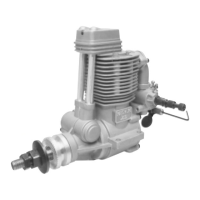INTRODUCTION
BECOMING FAMILIAR WITH YOUR ENGINE
If you are familiar with the operation of model engines or just can’t wait to
run your new engine, please read through the Quick-Start Guide included.
This guide will help you get started right away and also includes some good
recommendations. We do recommend reading through these Operating
Instructions in their entirety to familiarize yourself with the features and
operation of your new engine. We have also included a Troubleshooting
Guide should you encounter any problems.
Please use the photos below to familiarize yourself with the components of
your new Magnum XL RFS series engine.
1
CAUTION - PLEASE READ!!
Global Services 18480 Bandilier Circle Fountain Valley, CA 92708 Phone: (714) 963-0329 Fax: (714) 964-6236 Email: service@globalhobby.com
Both Engines Feature:
●
Ringed-Piston Design for Long Life and High Power
●
Rear-Updraft, Dual-Needle Carburetor w/Choke
●
High-Flow Quiet Muffler
●
Dual Ball Bearing-Supported Crankshaft & Camshaft
●
Dual Bushing-Supported Connecting Rod
Thank you for choosing a Magnum XL RFS series aircraft engine. The XL .80RFS
and .91RFS engines are single cylinder, four-stroke engines incorporating
an aluminum piston, iron ring and steel sleeve for long life and high power
output. A dual needle valve carburetor for precise fuel/airflow metering is
standard. Both engines feature a ball bearing-supported crankshaft and
camshaft, dual bushing-supported connecting rod, and a high-flow muffler
for more power and reduced noise. Your Magnum XL RFS series engine
was designed by expert engineers and built by master craftsmen using only the
highest quality materials and CNC machinery. These qualities provide the long
life and dependability you have come to expect from an engine of this caliber.
Magnum XL RFS series model airplane engines will consistently give you
dependable performance and reliability and will be a source of satisfaction
and pleasure if you follow these instructions as to the engine’s proper and
safe use. You alone are responsible for the safe operation of your engine,
so act sensibly and with care at all times. This Magnum XL RFS series
model airplane engine is not a toy. It is a precision-built machine whose
power is capable of causing serious injury to yourself and others if abused or
misused, or if you fail to observe proper safety precautions while using it.
●
Keep spectators, especially small children, at least 20 feet away from the
engine while it is running.
●
Mount the engine securely in the airplane or on a suitable engine test
stand to run the engine. Follow the mounting instructions in your kit's
instruction manual or on the plans for individual mounting recommendations.
Do not clamp the engine in a vise to test-run it.
●
Use the recommended size propeller and follow the proper procedure for
mounting the propeller. Use the correct size wrench to tighten the propeller
nut and the safety nut. Do not use pliers.
●
Inspect the spinner, propeller, and propeller and safety nuts on a regular
basis, looking for any signs of nicks, cracks or loosening.
●
To stop the engine, adjust the throttle linkage to completely close the throttle
barrel and therefore cut off the fuel/air supply. You can also pinch the fuel
line to stop the engine, but only if it is accessible. Do not throw anything into
the spinning propeller or attempt to use your hands to stop the engine.
●
While the engine is running, stand behind the engine to make any
adjustments to the needle valves. Do not reach over or around the propeller.
Do not lean toward the engine. Do not wear loose clothing or allow anything
to be drawn into the spinning propeller while the engine is running.
●
If you need to carry your model while the engine is running, be conscious
of the spinning propeller. Keep the airplane pointed away from you and
others at all times.
●
Do not use tight-fitting cowls over the engine. They can restrict air from
flowing over the engine, which could result in engine damage from overheating.
ENGINE INSTALLATION
Engine Orientation
Your XL RFS series engine can be orientated in any position on the firewall.
Keep in mind that when the engine is mounted inverted, carburetor
adjustments will need to be made differently and the fuel tank may need to
be lowered. (See fuel tank size and orientation to carburetor on the next page.)
OPERATING
INSTRUCTIONS
Displacement: ................ .80ci (12.8cc) / .91ci (14.95cc)
Bore: ............................... 26.5mm / 27.7mm
Stroke: ............................ 24.8mm / 24.8mm
Practical RPM: ............... 2,000 - 12,000 / 2,000 - 12,000
Weight: ............................ 20.0oz / 20.7oz (w/o Muffler)
21.7oz / 22.4oz (w/ Muffler)
XL .80RFS/.91RFS ENGINE SPECIFICATIONS
For XL .80RFS and XL .91RFS
Series Four-Stroke Engines

